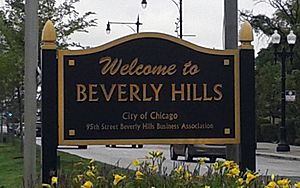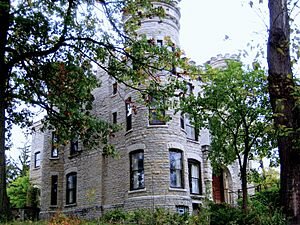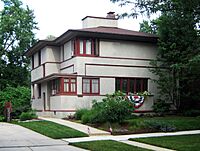Beverly, Chicago facts for kids
Quick facts for kids
Beverly
|
|
|---|---|
| Community Area 72 - Beverly Hills | |

Welcome sign at the corner of 95th Street and Western Avenue
|
|

Location within Chicago
|
|
| Country | United States |
| State | Illinois |
| County | Cook |
| City | Chicago |
| Neighborhoods |
List
Beverly
East Beverly North Beverly West Beverly |
| Area | |
| • Total | 3.19 sq mi (8.3 km2) |
| Population
(2020)
|
|
| • Total | 20,027 |
| • Density | 6,278/sq mi (2,424/km2) |
| Demographics (2021) | |
| • White | 55.3% |
| • Black | 32.4% |
| • Hispanic | 7.2% |
| • Asian | 1.3% |
| • Other | 3.7% |
| Time zone | UTC-6 (CST) |
| • Summer (DST) | UTC-5 (CDT) |
| ZIP Codes |
parts of 60620, 60643, 60655
|
| Area Codes | 773, 872 |
| Median income (2021) | $113,824 |
Beverly, officially called Beverly Hills, is one of Chicago's 77 official community areas. It is located about 12 miles (19 km) from the heart of Chicago, known as the Loop. You can find Beverly on the city's far south side.
Beverly is part of a special area called the Blue Island Ridge. This ridge also includes nearby places like Morgan Park, Mount Greenwood, Washington Heights, and the city of Blue Island. In 2020, Beverly had a population of 20,027 people.
For a long time, Beverly didn't have many people living there. It became part of the Village of Washington Heights in 1874. Then, businesses from Chicago started to develop the area. In 1890, Chicago officially took over Beverly. The area kept growing, especially after the Rock Island Railroad was finished. This train line runs along the eastern side of the Blue Island Ridge. It goes all the way to LaSalle Street Station in downtown Chicago. Because Beverly was on the ridge, it became a special neighborhood with large homes and big yards. It was known as a "streetcar community," meaning people used streetcars to get around.
Contents
Beverly's Interesting History
How Beverly Got Its Name
In 1889, the Rock Island Railroad changed its train tracks. It added more service north of 99th Street. A new train station opened at 91st Street and was named "91st Street–Beverly Hills station". By the late 1910s, the telephone system also used "Beverly" for its exchange.
No one is completely sure why the name "Beverly Hills" was chosen. Some people think it was named after Beverly, Massachusetts. This idea came from Alice Helm French, an important resident. She was married to the first director of the Art Institute of Chicago. Others believe the Rock Island Railroad simply named it after the area's hilly land. It's important to know that it was not named after Beverly Hills, California. That city got its name almost 20 years after Chicago's 91st Street Station was named.
Beverly in the 1800s
Before European Americans settled here, the Potawatomi people lived in Beverly. In 1833, after the Black Hawk War, the Potawatomi were asked by the United States government to move from their lands.
The first known non-Native American settlers were DeWitt Lane and Norman Rexford. Lane settled near 103rd Street in 1832. Rexford opened a tavern near 91st Street. This area became known as a "dry settlement." This meant that selling alcoholic drinks was not allowed. A lasting community started when John Blackstone bought land in 1839. In 1844, Blackstone sold land along the Blue Island Ridge to Thomas Morgan. The nearby area of Morgan Park is named after him.
Beverly began to change into a suburban area in 1869. Thomas Morgan's family sold his lands to a company. The area grew a lot after the Great Chicago Fire in 1871. Many Chicagoans who lost their homes moved here. Beverly became a popular place with new schools in the 1870s. In 1874, much of Beverly became part of the Village of Washington Heights. In 1890, the northern part of Beverly joined the City of Chicago.
Beverly's Location and Landscape
Beverly Hills is Community Area #72. It is on Chicago's far south side. It is about 12 miles (19 km) from the Loop. Its northern edge is 87th Street. Its southern edge is 107th Street. The community covers an area of about 3.19 square miles (8.26 km²). Beverly is connected to the Interstate highway system by I-57, which is just to the east.
Beverly, Morgan Park, Mount Greenwood, Washington Heights, and Blue Island are all part of the Blue Island Ridge. This ridge was formed long ago by glaciers. It was once an island in a lake. Later, it became part of the lake's western shore. This unique history makes it a special place in Chicago. It is the highest point in Chicago, almost 100 feet (30 m) above Lake Michigan. It was named for its blue color, perhaps from the sky or blue wildflowers.
In 2018, over half of Beverly's land (51.3%) was used for single-family homes. Only a small part was for businesses (3.2%) or apartments (2.9%).
Most of the homes in Beverly are single-family houses (78.7%). This is much higher than the city average. Most of these houses were built before 1969. The average house in Beverly has 7.4 rooms. About 92% of the homes are lived in. Most of these homes (85.3%) are owned by the people living in them.
People and Community in Beverly
| Historical population | |||
|---|---|---|---|
| Census | Pop. | %± | |
| 1930 | 13,793 | — | |
| 1940 | 15,910 | 15.3% | |
| 1950 | 20,186 | 26.9% | |
| 1960 | 24,814 | 22.9% | |
| 1970 | 26,797 | 8.0% | |
| 1980 | 23,360 | −12.8% | |
| 1990 | 22,385 | −4.2% | |
| 2000 | 21,992 | −1.8% | |
| 2010 | 20,034 | −8.9% | |
| 2020 | 20,027 | 0.0% | |
| Source: | |||
Before European Americans arrived, the Potawatomi people lived here. In 1833, they were asked to move west by the government.
Early white settlers in Beverly were mostly English and Protestant. But by the early 1900s, many Irish Americans moved into the neighborhood. New Roman Catholic churches and businesses were built. This made Beverly a strong center for Chicago's South Side Irish community.
In 2020, 20,027 people lived in Beverly. This number has stayed about the same since 2010. In 2021, the population was 55.3% white and 32.4% Black. About 7.2% of the people were Hispanic or Latino. Beverly is known for being one of Chicago's most racially mixed neighborhoods. It has a high percentage of Black residents in a mostly white area.
The age range of people in Beverly is wide. About 23.6% are under 19 years old. The median age is 45, which is older than the city average. Most people (92.0%) speak only English at home.
The average household income in Beverly was $113,824 in 2021. This is much higher than the city average of $65,781. Many households (36.3%) earned more than $150,000 per year.
Jobs and Money in Beverly
In 2021, about 66.3% of Beverly's population was working or looking for work. The unemployment rate was 7.6%, which was a bit lower than Chicago's rate. Many people (36.8%) who live in Beverly work outside of Chicago. About 32.0% work in the Loop.
For Beverly residents, education was the biggest employer (18.0%). Health care (13.4%) and public administration (12.5%) were also major job areas. Within Beverly itself, the top industries for jobs were transportation, professional services, hotels and restaurants, retail, and health care.
Main business areas in Beverly are along Western Avenue and 95th Street. There are also business areas around the train stations at 99th Street and 103rd Street.
Getting Around Beverly
Public Transportation
Beverly has five Metra train stations on the Rock Island District line. These trains go to LaSalle Street Station in downtown Chicago. They also go to the Joliet Transportation Center. The stations are at 91st, 95th, 99th, 103rd, and 107th Streets. They are all very close to each other.
The 95th/Dan Ryan station on the Chicago Transit Authority (CTA)'s Red Line is nearby in Roseland. This is a very busy train station. Local buses also serve Beverly. These include CTA routes 95, 103, and 112. Some Pace bus routes also run here.
Driving and Walking
In 2021, most homes in Beverly had two cars available (45.8%). Many also had one car (36.1%). Only a small number of homes (4.3%) had no cars. Most workers (63.0%) drive alone to work. About 10.0% work from home. Others use public transit (18.1%), carpool (5.0%), or walk or bike (2.5%).
Most of Beverly is easy to walk around. This means there are many people and jobs close by. There are also many trees and amenities.
Schools and Learning in Beverly
Beverly has several schools in the Chicago Public Schools system. These include Elizabeth H. Sutherland, Alice L. Barnard, and Kate Starr Kellogg elementary schools. Vanderpoel Magnet Elementary School is also here. The community also has three private, Catholic elementary schools: St. Barnabas, St. John Fisher, and Christ the King.
In 2021, many adults in Beverly had a college degree. About 30.4% had a bachelor's degree. Another 28.0% had a higher degree, like a master's or professional degree.
The Chicago Public Library opened a branch on 95th Street in 2009. It has a special design that is good for the environment. This library has the largest collection of Irish heritage materials in Chicago. You can also see several art pieces inside the library. These include sculptures and paintings by different artists.
Parks and Fun in Beverly
Many parks in Beverly were once part of the Ridge Park District. This was a separate park system before joining the Chicago Park District in 1934. Beverly has about 2.0 acres (0.81 ha) of park space for every 1,000 residents. This is a good amount of green space.
Some of the parks in Beverly include Barnard, Ridge, Hurley, Cosme, Graver, Munroe, Beverly, Ridge Wetlands, and King-Lockhart parks.
- Barnard Park was created when Erastus A. Barnard gave 2.36 acres (0.96 ha) of land. He named it after his daughter, Amy. The park has a playground and open space for sports and picnics.
- Ridge Park is a 10-acre (4.0 ha) park started in 1908. It is named after the tree-covered ridge it sits on. The park has three baseball fields, a playground, tennis courts, and a walking path. It also has war memorials. The park's main building, called a fieldhouse, has a gym, swimming pool, and fitness center. It also holds the Vanderpoel Memorial Art gallery, which has about 500 artworks.
- Hurley Park is a 1.54-acre (0.62 ha) park from 1923. In 1984, it was named after Father Timothy Hurley. He started the St. Barnabas Catholic parish nearby. The park has a playground and a nature preserve.
- Cosme Park is a 4.23-acre (1.71 ha) park started in 1927. It was named after Margaret Cosme, a young girl who sadly died after being hit by a car. Her father and grandfather helped build the park's baseball field. The park also has a playground and tennis courts.
- Graver Park is a 4.97-acre (2.01 ha) park built in the late 1920s and early 1930s. Its fieldhouse has an auditorium and other rooms. Outside, it has a water park, tennis courts, a playground, and fields for softball, baseball, and soccer. It was named after Philip S. Graver, who was a leader of the Chicago Park District.
- Munroe (Roy) Park is a 5.69-acre (2.30 ha) park. It has a multi-purpose field, two baseball fields, two playgrounds, and a running track. It was transferred to the Chicago Park District in 1961.
- Beverly Park is a large 13.56-acre (5.49 ha) park. It was created in 1947. It has tennis courts, volleyball courts, a playground, and baseball fields. There is a special memorial in the park for Cpl. Conner T. Lowry. He was a Marine who died in Afghanistan in 2012. He asked his mother to remember him at Beverly Park. A bronze statue of a marine's boots, rifle, and helmet was placed there.
- Ridge Wetlands Park is a 1.21-acre (0.49 ha) park. It was bought in 1991 to protect its wooded wetlands.
- King-Lockhart Park is a 0.56-acre (0.23 ha) park and plaza. It is named after Chicago firefighters Patrick King and Anthony Lockhart. They died fighting a fire at this spot in 1998. Two pergolas (garden structures) mark where they died.
Famous Places in Beverly
- Givins Beverly Castle (also known as the Givins Irish Castle): This is a very famous building in Beverly. It's at 103rd Street and Longwood Drive. Robert C. Givins built it in 1886 and 1887. He was inspired by castles in his home country of Ireland. He lived there until 1894. The castle has three stories and three towers. It has been updated over the years, but its outside look is still the same. The Beverly Unitarian Church now owns it. It's the only building like it in Chicago. Some people even say it's haunted!
- Beverly/Morgan Railroad District: This is a group of six old train stations. Four of them are in Beverly: the 91st Street, 95th Street, 99th Street, and 107th Street stations. These stations were built between 1889 and 1945. They are rare examples of old train station architecture in Chicago. They were named a Chicago Landmark in 1995.
- Longwood Drive District: This area includes houses along Longwood Drive. They sit on a famous hill. The houses were built starting in 1873. Longwood was named for a long group of trees on the hill. Many wealthy Chicagoans built grand homes here because it was a beautiful, rural area. The houses show many different styles of architecture. These include Italianate, Carpenter Gothic, Queen Anne, and Prairie School. This district became a Chicago Landmark in 1981.
- Guy C. Smith and H. Howard Hyde Houses: These two houses are special "American System-Built Homes". They are at 10410 and 10541 South Hoyne Avenue. Frank Lloyd Wright designed them in 1917. The first house was meant to be part of a group of homes. Both are two-story, single-family houses. They were named Chicago Landmarks in 1994.
- William and Jessie M. Adams House: This house is a Prairie school style home. It is at 9326 South Pleasant Avenue. Frank Lloyd Wright built this square, two-story house between 1900 and 1901. It became a Chicago Landmark in 1994.
- Walter Burley Griffin Place District: This area is along the 1600–1800 blocks of West Griffin Place. It has homes built between 1909 and 1914. Seven of these homes were built by Walter Burley Griffin. This district was named a Chicago Landmark in 1981.
Famous People from Beverly
Many interesting people have lived in or are from Beverly:
- Lance Ten Broeck (born 1956), a professional golfer.
- Mike Castle (born 1989), an actor known for the TV show Clipped.
- William Cunningham (born 1967), a member of the Illinois Senate.
- Count Dante (1939–1975), a martial artist.
- Richard Duchossois (born 1921), a businessman and owner of Arlington Park.
- Elizabeth Ann Doody Gorman (born 1968), a former member of the Cook County Board of Commissioners.
- Mike Hagerty (1954–2022), an actor who stayed connected to Beverly.
- Henry K. Holsman (1866–1963), a car manufacturer.
- Michael Howlett (1914–1992), a former Secretary of State of Illinois.
- Daniel Hynes (born 1968), a former Illinois Comptroller.
- Thomas Hynes (1938–2019), a former President of the Illinois Senate and Cook County Assessor.
- John R. Lausch Jr. (born 1970), a U.S. Attorney.
- Richard H. Lawler (1895–1982), a pioneer in organ transplants.
- Vincent LoVerde (born 1989), an American Hockey League player.
- Morgan F. Murphy (1932–2016), a former member of the United States House of Representatives.
- P. Scott Neville Jr., a judge on the Illinois Supreme Court.
- Matthew O'Shea (born 1969), a member of the Chicago City Council.
- Craig Robinson (born 1971), an actor and comedian from The Office.
- Ethel Spears (1903–1974), an American painter.
- John Paul Stevens (1920–2019), a former Associate Justice of the Supreme Court of the United States.
- Daniel Sunjata (born 1971), an actor.
- Marie H. Suthers (1895–1983), a longtime member of the Chicago Board of Elections.
- Duke Tumatoe (born 1947), a blues musician.
- James C. Tyree (1957–2011), a chief executive officer.
- Paul Vallas (born 1953), a school superintendent.
- Lana (born 1965) and Lilly Wachowski (born 1967) (known as The Wachowskis), film directors famous for The Matrix trilogy.
- D. Everett Waid (1864–1939), an architect.
- George Wendt (born 1948), an actor and comedian known for Cheers.
- Jamila Woods (born 1989), a poet and musician.
- Graham Elliot (born 1977), an American Chef and TV host.





